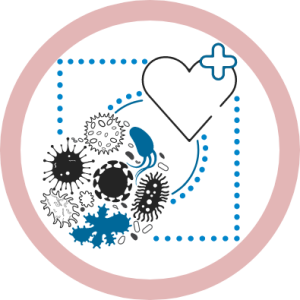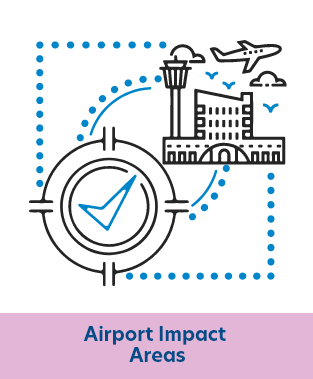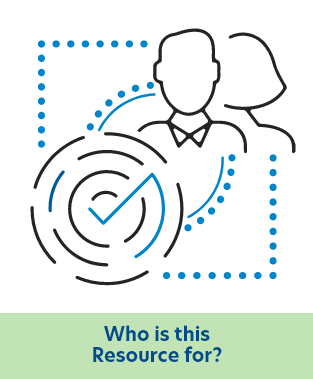
Communicable Diseases in an Airport Setting
Communicable Diseases Overview
Communicable diseases are illnesses caused by microorganisms (usually bacteria, viruses, or parasites) transmitted from one person or animal to another. These microorganisms are often referred to as the agents of communicable diseases, and they vary in how infectious they are as well as in how dangerous or deadly the resulting infection can be to a human host. For example, a disease like measles is highly infectious but unlikely to be lethal, whereas Ebola virus disease is much more lethal but less easily spread from person to person. The more transmissible and/or the more deadly an infectious agent is, the more of a concern there will be for taking precautions against its spread in any environment, including an airport environment.
The Bubonic Plague of the Middle Ages, the Spanish influenza in 1918-1920, and the H1N1 Influenza in 2009 are a handful of examples that caused the deaths of millions globally. Starting in 2019, the emergence and spread of a novel communicable disease, Severe Acute Respiratory Syndrome Coronavirus (SARS-CoV-2), resulted in an unprecedented and complete disruption of everyday life across the globe. The unique characteristics of each pathogen should be assessed when considering its potential to spread and overall impact within an airport environment.
All infectious agents have a habitat in which they naturally live, grow, and multiply, called a reservoir. Reservoirs can include humans, animals, and the environment. There are several different ways in which a pathogen can be transmitted from its natural reservoir to a susceptible host. These are referred to as “modes of transmission,” and include the following classifications and routes:
- Direct transmission: the infectious agent is transferred from a reservoir to a susceptible host by direct contact or droplet spread.
- Direct contact: skin-to-skin contact, kissing, and sexual intercourse.
- Respiratory (droplet) spread: large, short-range aerosols produced and sprayed by sneezing, coughing, or even talking.
- Indirect transmission: the transfer of an infectious agent from a reservoir to a host by suspended air particles, inanimate objects (vehicles), or animate intermediaries (vectors).
- Airborne spread: the infectious agent is carried by dust or droplet nuclei suspended in air. The infectious agent may remain suspended in the air for long periods of time and may be blown over great distances. Airborne dust includes material that has settled on surfaces and become resuspended by air currents as well as infectious particles blown from the soil by the wind.
- Vehicleborne: the passive carrying of a pathogen by food, water, biological products such as blood, and fomites, which include inanimate objects such as handkerchiefs.
- Vectorborne: passive carrying of a pathogen by hosts such as fleas, mosquitoes, and ticks.
- Direct transmission: the infectious agent is transferred from a reservoir to a susceptible host by direct contact or droplet spread.
Communicable Diseases in an Airport Setting
Exposure Concerns
Maintaining in-person operations during the COVID-19 public health emergency proved to be a challenge for many airports. The risk of exposure to the disease made leadership reconsider many of their routine operations. Significant changes were made to many operations including the move to telework, changes in staff scheduling, and limiting face-to-face time between employees and passengers as much as possible. In-person operations were modified to reduce the risk of exposure for personnel and customers.
Activities involving large in-person groups were discouraged during the COVID-19 public health emergency. Several airports needed to participate in mandatory Federal Aviation Administration (FAA) drills scheduled during the COVID-19 pandemic. Because the drills require large groups of people to interact with each other in person, such events can pose a risk to both staff health and operations in the event of staff exposure or infection. One airport noted that they had to conduct a full-scale exercise with local fire departments, medical facilities, and airport operations and maintenance staff for compliance requirements at a time when it was unsafe to interact closely with a large group of people. Future planning should consider contingencies where possible for critical operations that traditionally require in-person events.
Facility Limitations
While some airports had designated quarantine locations, these areas were often set up to hold only a few people and were not designed to support the number of positive cases identified during the COVID-19 pandemic, making it difficult to manage and isolate positive cases. Additional problems were caused by a lack of designated space available to meet the new needs created by the pandemic, such as storage space for cleaning products or areas for testing and vaccination clinics. This hindered the respective lines of effort airports were trying to support. Multiple airports had to develop alternative methods to find space within their facilities to establish areas for isolation spaces and clinics. Some utilized terminals that were closed off to the public to manage confirmed positive cases in the airport facility or set up testing clinics without putting their staff or the public at risk.
Janitorial and Disinfecting Operations
Due to the increased cleaning frequency of the airport facilities during the COVID-19 pandemic, areas needed to be temporarily closed off to the public, which required passengers to be directed to alternate locations in the airport. Many airports did not have designated areas to move passengers to in case of a decontamination event, which happened when an infected individual was identified in a specific area of the airport. This created additional challenges when trying to follow social distancing recommendations. The decontamination procedures allowed airports to respond accordingly and maintain a higher degree of cleanliness but negatively impacted the normal flow and boarding of passengers, requiring airports to adjust the operational pace which led to delays at times. One airport had to close off an entire Transportation and Security Administration (TSA) checkpoint for cleaning after a confirmed positive COVID-19 case was identified. This cost the operation thousands of dollars in re-transiting passengers to a different TSA checkpoint which caused passengers to miss their flights or caused airlines to have schedule delays.
Social Distancing
Maintaining social distancing measures within the airport facility is hard to implement. Some large airports can effectively divide areas and distribute people throughout the space, but many smaller airports do not have enough space to socially distance crowds due to the volume of passengers that need to be in certain areas during peak hours and boarding times. Implementation of on-the-spot modifications to facilities’ layouts was challenging, especially when they needed to be completed as quickly as possible, with minimal operational disruptions. Some modifications implemented included putting up physical plastic barriers at the ticket counters and gates, removing seats, manufacturing stands to place hand sanitizers within high contact areas, and putting up signage and stickers for guidance. These modifications were especially hard to implement in the TSA and Customs and Border Protection (CBP) security checkpoints because that is where passengers are the most anxious, in a hurry, and where long wait times are anticipated. Making these modifications meant that the checkpoints needed to be closed off for a period, which interfered with airport operations and required passengers to be redirected to other checkpoints, further increasing wait times.
Airport’s Role in Addressing Spread
Cleaning and Disinfection Protocols for the Airport
During a communicable disease incident, airports must review and revise their steady-state cleaning procedures to ensure they will meet new disinfection requirements. This may involve changes to standard cleaning operations, as well as the development of rapid decontamination processes for potential contamination sites inside the facility. It is the responsibility of airports to identify high-risk areas of infection and increase the frequency of cleaning procedures, as well as provide personal protection equipment (PPE) to janitorial staff.
To identify high-risk areas, airports can refer to existing literature for relevant information and they can also partner with universities and local health departments to develop pilot studies. Enhanced cleaning throughout the airport, especially in high-risk areas such as security checkpoints, bathrooms, escalators, and gate seating areas allows for greater mitigation of the spread of the communicable disease.
Cleaning Products
Different airport leadership teams and tenants sometimes disagreed on what disinfectants to use on the facilities, how often they should be cleaned, and how long the cleaning product needed to stay wet on the surface to ensure efficacy against the virus.
Multiple external sanitation organizations claimed to have the most effective products but offered little to no scientific explanations or data to support these claims. Many airports spent significant amounts of time and money on products without knowing their true effectiveness, which made the disinfecting processes inefficient and sometimes ineffective, and sometimes caused deleterious side effects such as surface damage and deterioration in some cases. For example, some of the disinfecting wipes used left a white film over the chairs after a certain period and also clogged up the plumbing system due to passengers throwing them in the toilet. However, multiple airlines utilized these products to increase the comfort and sense of trust with their customers.
COVID-19 Testing
There are many different testing modalities available for COVID-19. Some tests are used to detect the current presence of the virus in an individual, and other tests look for evidence that the individual was infected in the past. There are two main types of tests meant to identify current infection: nucleic acid amplification tests (NAATs) and antigen tests. In certain circumstances, one test type may be recommended over the other. All tests should be performed following the Food and Drug Administration’s (FDA’s) requirements.1 NAATs, such as polymerase chain reaction (PCR)-based tests, are most often performed in a laboratory. Per the Centers for Disease Control and Prevention (CDC), PCR tests are typically the most reliable tests for people with or without symptoms since they can detect viral genetic material that may reside within an individual’s body for up to 90 days after they test positive. Knowing this, the CDC recommends that an individual not use a NAAT if they have tested positive in the last 90 days.2
Antigen tests, also sometimes known as “at-home tests,” were offered by many airports once they became readily available. These tests could be self-administered and could be mailed in for employees and their families to do at-home testing. Some also offered services for medical representatives to come into the non-secured area of the airport to offer tests for the staff and tenants. Airports that were not able to offer testing on-site offered transportation to testing facilities, which they noted as being appreciated by their employees. Airports should note that any onsite testing should be implemented after reviewing CDC guidelines or consulting with the local health department.
Developing a Communicable Disease Response Plan
Per the U.S. Government Accountability Office (GAO), U.S. airports and airlines are not required to have individual preparedness plans and no federal agency tracks which airports and airlines have them.3 Information found in Chapter 2 of the 2019 ACRP Insight Events Proceedings “Airport Roles in Reducing Transmission of Communicable Diseases”4 emphasized the importance of risk management in preventing the spread of communicable diseases. Airport representatives participating in this event agreed that having a communicable disease plan in place provided guidelines and gave airports more of a proactive approach and control during the COVID-19 pandemic.
To successfully develop a plan, airports should incorporate guidelines and procedures from prior outbreaks and public health incidents. Having a communicable disease plan with a section uniquely targeting pandemic/epidemic procedures will provide clear, generalizable guidelines to follow in a time that may be hectic and require quick action. Airport authorities who did not have a communicable disease plan in place used playbooks and guidelines created from the previous Severe Acute Respiratory Syndrome (SARS) outbreak in 2003 and the Ebola outbreak in 2013. For example, during the 2013 Ebola outbreak, a screening process was developed. The first step of the process was notifying all passengers the screenings would be conducted at entry and exit for any person who met certain risk criteria. Next, a health declaration form was distributed to the passengers with a questionnaire to determine who was at risk. Finally, a screening was conducted to check for elevated temperature, the potential for exposure, and self-reported or observed signs of symptoms. The 2003 SARS outbreak response used a similar approach heavily focused on health alert notices to travelers arriving from regions with SARS. These notices informed airports and travelers of potential exposures and the common symptoms. Airports during the COVID-19 pandemic found this use of communication, tracking, and health alert notices to be highly beneficial and included them as part of their emergency pandemic/epidemic response plans. Creating different sections in the Communicable Disease Response Plan (CDRP) specific to distinct types of pathogens most relevant to airport settings based on their mode of transmission (e.g., direct contact or airborne) may be beneficial.
Employee Contact Tracing
When one employee tested positive for SARS-CoV-2, it was important for airports to perform contact tracing to understand which additional employees could potentially be at risk of contracting the virus. Maintaining the confidentiality of the infected and exposed employees is essential. Some airports only informed exposed individuals that they had been exposed to the virus and were then given further guidelines on quarantine and isolation requirements. Much of the contact tracing was conducted by looking through the infected employee’s schedule to identify who had been exposed during the same shift, or by gathering information from the infected employee. Airports should include contact tracing procedures in their CDRP.
International Passenger Screening
The Department of Homeland Security offers expedited lanes and screening processes when crossing international borders through their “Trusted Traveler Programs.” These programs, including Global Entry, Nexus, Sentri, and the Free and Secure Trade program, help minimize both the contact and the exposure time for passengers and officers. Encouraging the participation of passengers and flight crews in these programs allows for expedited inspection and clearance, helping to reduce the queuing lines at the Federal Inspection Station.
Managing Positive Cases
The COVID-19 pandemic was challenging in part due to the sheer volume of infected people traveling through the airport facility and the elevated risk of exposure for staff and operators. Multiple airports had a CDRP that did not apply to a pandemic/epidemic situation but was instead implemented for smaller-scale events, such as the presence of passengers or employees infected by diseases such as Ebola or tuberculosis. Once the volume of confirmed positive COVID-19 passengers and employees exceeded levels accounted for in the CDRPs, airports had to implement measures outside of the plans to adequately quarantine infected individuals. This increased the risk of exposure for airports’ tenants, employees, and customers, and contributed to staffing shortages.
A considerable amount of time and resources were utilized to perform contact tracing and track the health and status of all employees who had been exposed to infected individuals and/or who were out sick. While some airports’ CDRP procedures required the removal of passengers who tested positive for COVID-19 from airplanes, some gateway airports (i.e., the last U.S. airport from which the traveler’s flight departs or the first U.S. airport at which the traveler’s flight arrives) noted that their CDRP did not include guidelines on what to do with the positive passengers in the airport after they were removed from the airplane. Airports had to coordinate across numerous emergency response groups to develop Standard Operating Procedures for these scenarios.
Response and Evaluation
The primary role of airports in responding to a communicable disease threat is to understand what the disease is, how it spreads, and how to protect employees and customers in a timely and flexible manner. Airports should re-evaluate the procedures in their CDRP regularly to ensure they are incorporating up-to-date information and employing effective approaches to managing public health incidents. Being quick to respond during a pandemic event will ensure airports are taking an active role in managing the elements that they can control to reduce the impact and spread of the disease, as well as recover faster. Airports cited flexibility and adaptability as critical to success in a public health emergency environment. Since COVID-19 was an airborne virus, social distancing was critical to keeping their employees, tenants, and customers safe. Many airports had to make drastic changes to their plans and operations by adapting and training their workforce to work from home, as well as adjusting the layout of many areas within the airport.
Safety
As transportation hubs, airports have a responsibility to provide safe environments for staff, tenants, and travelers. During pandemic operations, this included instituting mitigation measures throughout the airport, providing appropriate equipment and tools where necessary, and providing enhanced cleaning procedures to prevent spread of communicable diseases. Airports need to provide an environment where their employees feel safe and can perform their duties efficiently during both steady state and emergency operations.
Vaccination and Testing Policies
Airports and airlines offered different incentives to encourage frequent employee testing and, eventually, vaccination. Testing helped prevent the spread of infected individuals, including those who were asymptomatic. Some airports, including Portland International Jetport, collaborated with local health professionals to host public vaccination clinics onsite that airport employees and travelers could use as well.
[1] Centers for Disease Control and Prevention. (n.d.). Covid-19 testing: What you need to know. Centers for Disease Control and Prevention. Retrieved September 29, 2022, from https://www.cdc.gov/coronavirus/2019-ncov/symptoms-testing/testing.html
[2] Centers for Disease Control and Prevention. (n.d.). Covid-19 testing: What you need to know. Centers for Disease Control and Prevention. Retrieved September 29, 2022, from https://www.cdc.gov/coronavirus/2019-ncov/symptoms-testing/testing.html
[3] U.S. GAO. (2015). “Air Travel and Communicable Diseases: Comprehensive Federal Plan Needed for U.S. Aviation System’s Preparedness.” www.gao.gov/products/gao-16-127
[4] Wilhelmi, J. (2019). Conference Proceedings 55: Airport Roles in Reducing Transmission of Communicable Diseases. Summary of a Workshop of the Airport Cooperative Research Program’s 2018 Insight Event. Transportation Research Board, Washington, DC. https://doi.org/10.17226/25367
Banner image credit: Unsplash



